
The massive extinction that killed off the dinosaurs may have also decimated lizards and snakes, according to new research.
In the past, researchers believed that the K-T extinction, which occurred around 65 million years ago, wiped out dinosaurs, but mostly spared lizards and snakes. But the new findings, published today (Dec. 10) in the Proceedings of the National Academy of Sciences, showed that about 83 percent of these reptiles went extinct.
"I think it is a pretty important piece of work," said Stephen Brusatte, a paleontologist from Columbia University who was not involved in the study. "It does a nice job of showing that extinction at the end of the Cretaceous really hit lizards and snakes hard."
The findings actually make the story of the end Cretaceous Era mass die-off more consistent, because it's hard to imagine a catastrophe capable of destroying the dinosaurs would spare lizards and snakes, said study co-author Nicholas Longrich, a paleontologist at Yale University. [Wipe Out: History's Most Mysterious Extinctions]
"You can't wipe out the dominant carnivores and dominant herbivores on the planet without causing devastation of the ecosystem on a massive scale," Longrich told LiveScience.
Mass die-off
Most researchers think a giant meteor crashing to Earth at the Yucatan peninsula caused the mass extinction that killed the dinosaurs. The impact likely released a sun-blocking cloud of dust into the atmosphere, preventing plants from making food and causing dinosaurs to die as a result.
Sign up for the Live Science daily newsletter now
Get the world’s most fascinating discoveries delivered straight to your inbox.
To see if lizards and snakes were somehow shielded from the doom, Longrich and his colleagues collected fossil records from the reptiles across North America. Before the extinction, snakes and lizards were flourishing, with 27 lizard species and three snake species documented in the fossil record. In the years immediately afterward, only five species remained, with most disappearing from the fossil record quite abruptly, Longrich said.
If most plants died, then plant eaters and their predators would have died off too, he added. It's likely that only scavengers and animals that preyed on them came out of the Cretaceous period relatively unscathed.
"When everything starts dropping dead, and everything dies, there's probably bugs and grubs and worms eating them and that's probably what the survivors were eating," Longrich said.
Global death?
The findings are consistent with an asteroid slamming into Earth and leading to the dino demise, Longrich said. (Just last week at the meeting of the American Geophysical Union, researchers presented an argument for volcanoes, not a space rock, doing in the dinosaurs.)
The new fossil analysis convincingly shows that reptiles faced a severe extinction in North America, wrote Richard Cowen, a geoscientist at the University of California, Davis, who was not involved in the study, in an email. Because the meteorite hit Chicxulub in Mexico, you would expect the greatest death toll within North America, but the researchers' case for a worldwide die-off from the space rock is much shakier, he said.
"In order to justify a global discussion of the K-T, the authors try to persuade us that the same effect that they document for North America happened worldwide, but they only mention a few data points from Asia," Cowen wrote.
Unfortunately, that may be the best evidence scientists have, because there aren't many fossils from before, during and after the extinction anywhere but North America, Brusatte told LiveScience.
Follow LiveScience on Twitter @livescience. We're also on Facebook & Google+.

Tia is the managing editor and was previously a senior writer for Live Science. Her work has appeared in Scientific American, Wired.com and other outlets. She holds a master's degree in bioengineering from the University of Washington, a graduate certificate in science writing from UC Santa Cruz and a bachelor's degree in mechanical engineering from the University of Texas at Austin. Tia was part of a team at the Milwaukee Journal Sentinel that published the Empty Cradles series on preterm births, which won multiple awards, including the 2012 Casey Medal for Meritorious Journalism.









